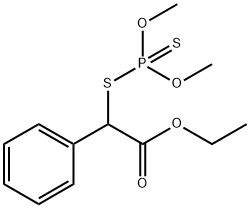
Phenthoate
- русский язык имя
- английское имяPhenthoate
- CAS №2597-03-7
- CBNumberCB9740624
- ФормулаC12H17O4PS2
- мольный вес320.37
- EINECS219-997-0
- номер MDLMFCD00145099
- файл Mol2597-03-7.mol
| Температура плавления | 17.5°C |
| Температура кипения | 75°C |
| плотность | approximate 1.23g/ml (20℃) |
| давление пара | 5.3×10-3 (40 °C) |
| температура хранения | 2-8°C |
| растворимость | Chloroform (Slightly), DMSO (Sparingly), Methanol (Slightly) |
| форма | liquid |
| Растворимость в воде | 10 mg l-1(25 °C) |
| цвет | Colorless to light yellow |
| Справочник по базе данных CAS | 2597-03-7(CAS DataBase Reference) |
| Рейтинг продуктов питания EWG | 2 |
| FDA UNII | J96Q7F091K |
| Справочник по химии NIST | Phenthoate(2597-03-7) |
| Система регистрации веществ EPA | Phenthoate (2597-03-7) |
| UNSPSC Code | 41116107 |
| NACRES | NA.24 |
| Коды опасности | Xn,N |
| Заявления о рисках | 21/22-50/53 |
| Заявления о безопасности | 22-36/37-60-61 |
| РИДАДР | UN 2810 |
| RTECS | AI7875000 |
| Класс опасности | 6.1(b) |
| Группа упаковки | III |
| кода HS | 29309090 |
| Банк данных об опасных веществах | 2597-03-7(Hazardous Substances Data) |
рисовальное письмо(GHS)
-
рисовальное письмо(GHS)


-
сигнальный язык
предупреждение
-
вредная бумага
H302:Вредно при проглатывании.
H410:Чрезвычайно токсично для водных организмов с долгосрочными последствиями.
H312:Вредно при попадании на кожу.
-
оператор предупредительных мер
P264:После работы тщательно вымыть кожу.
P270:При использовании продукции не курить, не пить, не принимать пищу.
P273:Избегать попадания в окружающую среду.
P280:Использовать перчатки/ средства защиты глаз/ лица.
P301+P312:ПРИ ПРОГЛАТЫВАНИИ: Обратиться за медицинской помощью при плохом самочувствии.
P302+P352:ПРИ ПОПАДАНИИ НА КОЖУ: Промыть большим количеством воды.
P312:Обратиться за медицинской помощью при плохом самочувствии.
P363:Перед повторным использованием выстирать загрязненную одежду.
P391:Ликвидировать просыпания/проливы/утечки.
P501:Удалить содержимое/ контейнер на утвержденных станциях утилизации отходов.
Phenthoate химические свойства, назначение, производство
Описание
Phenthoate is a colorless crystalline substance. Solubility in water is 10 mg/L (25 ?C). It is readily soluble in most organic solvents. Log Kow = 3.69. It is relatively stable in neutral and acidic aqueous media but decomposed under alkaline conditions.Использование
Phenthoate is an organothiophosphate insecticide used against lepidoptera and houseflies.Определение
ChEBI: An organic thiophosphate that is ethyl mandelate in which the hydroxy group has been replaced by a (dimethoxyphosphorothioyl)sulfanediyl group.Метаболический путь
Studies which have measured the degradation of phenthoate in buffered aqueous solution have shown that it can be hydrolysed at the carboethoxy group, by cleavage of the P-S and C-S bonds and by demethylation in addition to oxidative desulfuration to the oxon. Reports on the metabolism of phenthoate in plants, insects and mammals have shown that the metabolic products can be largely explained by cleavage of these reactive groups. P-S and C-S bond cleavage is demonstrated by the formation of both O,O-dimethyl phosphorothioate and O,O-dimethyl phosphorodithioate. Metabolism in plants, insects and mammals is similar with many of the possible metabolites being identified in most species. Phenthoate carboxylic acid is a major metabolite except in plants where hydrolysis of the phosphorodithioate moiety predominates. In mammals, little or none of the activated metabolite, phenthoate oxon, can be detected, suggesting that the predominant metabolic route is degradative, wkuch may in part explain the favourable mammalian toxicity of the compound.Метаболизм
Phenthoate is degraded by hydrolysis of the carboethoxy moiety. Demethylation and the cleavage of P?S?C linkages are also important degradation routes. Oxidative desulfuration to the oxon followed by hydrolysis occurs in animals and plants.The major metabolites excreted in the urine and feces are demethyl phenthoate, demethyl phenthoate acid, demethyl phenthoate oxon, and O,O-dimethyl hydrogen phosphorodithioate and phosphorothioate. It is rapidly degraded in soils; DT50 was less than 1 d in both upland and submerged soil.